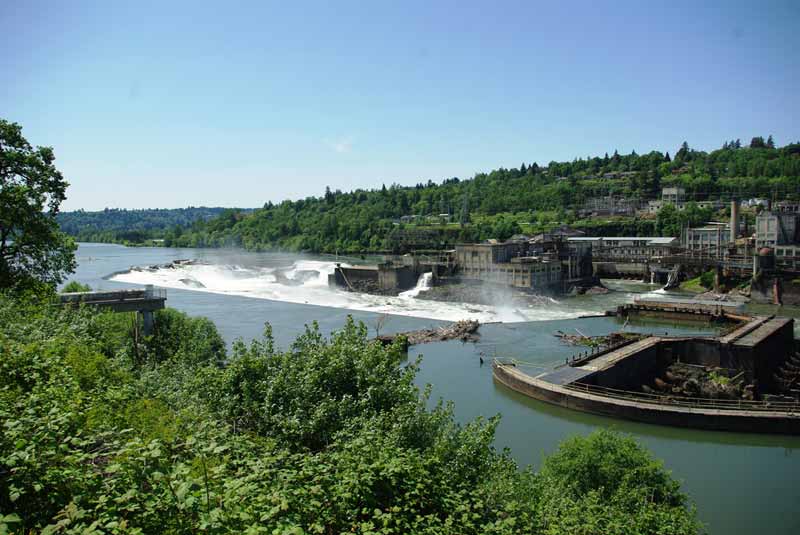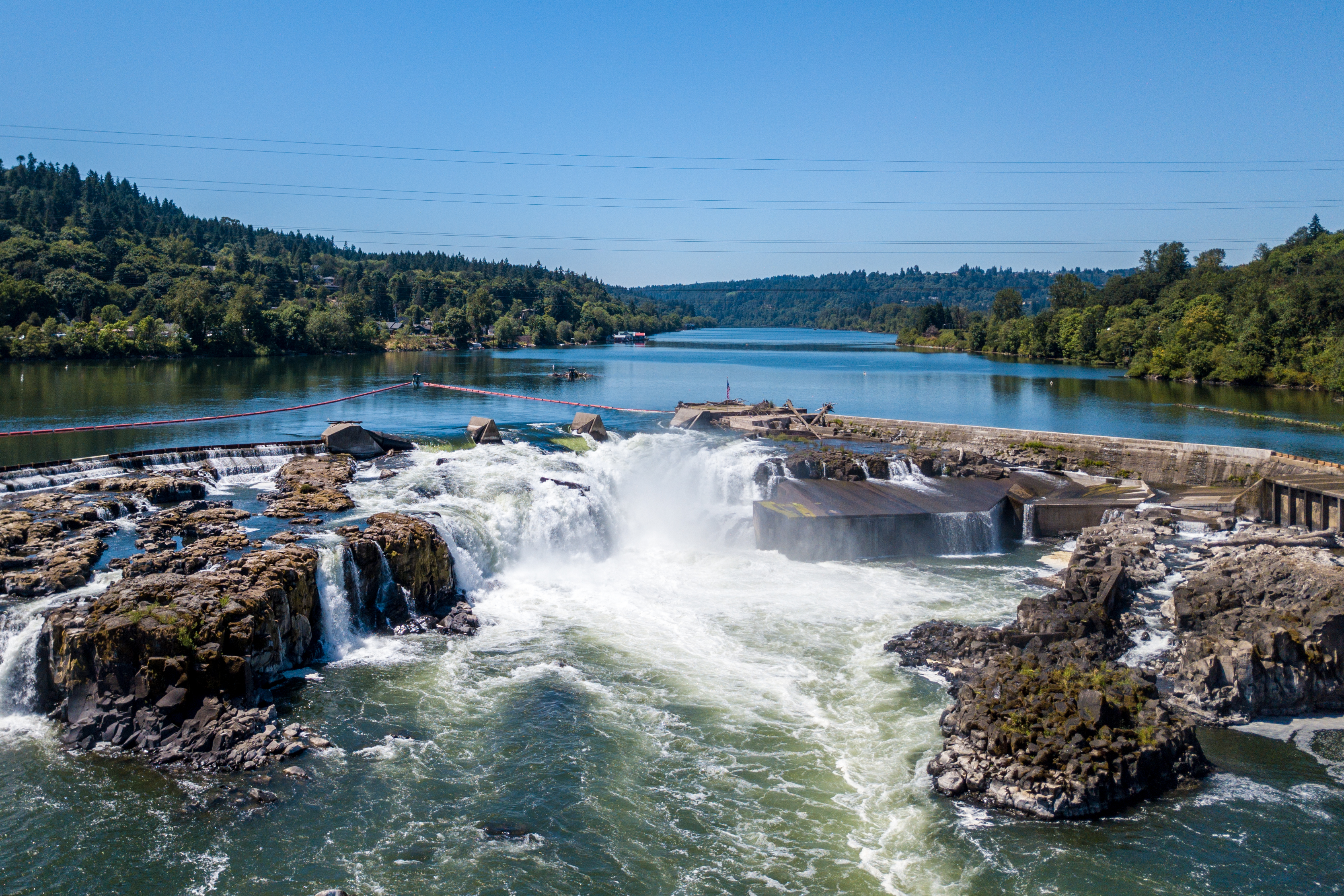Willamette Falls Oregon – Description | History | Travel | Location
Willamette Falls is the second strongest waterfall in North America and an important Oregon historic and cultural treasure. For more than 150 years, its awe-inspiring magnificence has been closed to the general public. Soon, it won’t be.
Willamette Falls Overview
Willamette Falls is a crucial location for many tribes. The abundance of salmon introduced tribal members from throughout to fish, commerce, and work together on the falls and created an economic hub for the area.
Despite the elimination of natives from the area, the significance of Willamette Falls continues to at the present time.
Each year the Grand Ronde Tribe harvests ceremonial salmon from a fishing platform at Willamette Falls and collects lamprey in the course of the summer season. Native Americans from different Tribes, equivalent to Warm Springs, additionally harvest Pacific Lamprey on the falls.
The Willamette Falls is a natural waterfall on the Willamette River between Oregon City and West Linn, Oregon, within the United States. It is the biggest waterfall within the Northwestern United States by volume and the seventeenth widest on the planet.
Horseshoe in form, it’s 1,500 feet (460 m) extensive and 40 feet (12 m) high with a stream of 30,849 cu ft/s (874 m³/s), positioned 26 miles (42 km) upriver from the Willamette’s mouth.
Until 2011 a canal and set of locks allowed vessels to go into the primary Willamette Valley. Those locks at the moment are closed.
The falls is a horseshoe formed block waterfall brought on by a basalt shelf within the river ground. The 40 ft (12 m) high and 1500 ft (457 m) extensive falls happen 26 river miles (42 km) upstream from the Willamette’s confluence with the Columbia River.
Operated by the U.S. Army Corps of Engineers, the lock was a 4 lock canal and was the oldest steady working, multiple lift navigation canal within the United States.
The public can view the falls from viewpoints on the bluffs of Oregon City, from a signed viewpoint alongside Highway 99E, from the Oregon City Bridge, from a viewpoint on northbound I-205, or from boats within the river.
Willamette Falls Description
Willamette Falls is a horseshoe-shaped block waterfall that plunges 40+ feet over a basalt ledge. On occasions of very high water, as within the floods of December 1996, solely about 10 feet of the waterfall might present.
The falls span the Willamette River between Oregon City and West Linn and have been a lot altered by human exercise. Several paper mills have been constructed next to the falls, the first one in 1866.
The final mill right here, that of the Blue Heron Paper Company, closed in 2011. A PGE hydroelectric plant constructed in 1888 is now a part of the Blue Heron Paper Mill complex.
A fish ladder was constructed in 1882 after which changed with a more efficient channel in 1971. A weir additionally runs throughout the top of the falls. In the mid-19th century, numerous river steamer firms had docks above the falls to take passengers up the Willamette River.
The portage route at Oregon City went over Canemah Bluff (See the Canemah Bluff Loop Hike). Later, a collection of 4 lock chambers was constructed in 1873 and was in steady use till 2011, after they have been closed. These have been the first multi-lift locks constructed within the United States.
Willamette Falls is the biggest waterfall by quantity within the Northwest, dropping 42 feet over a horseshoe-shaped ledge with a crest size of roughly 1,500 feet.
Prior to the event of the Oregon City area, it’s although the falls might have spanned as a lot as 2,500 feet throughout. Due to the industrialization of Oregon City, the falls have lost most of their natural enchantment.
The land on each side of the river instantly adjoining to the falls harbors, amongst different services, a hydroelectric station, a paper mill, and one of many oldest sets of operational locks within the United States.
An effort is presently under means by the municipality of Oregon City and the Confederated Tribes of Grand Ronde to revive a lot of the now-defunct industrial areas around Willamette Falls.
Work will start in 2020 to interrupt ground on the Willamette Falls Riverwalk, which can present up shut views of the falls to the general public for the first time in nicely over a century.
The Willamette River is among the largest rivers within the Pacific Northwest, draining a basin of over 10,000 sq. miles.
The natural average month-to-month quantity of the river on the falls varies from simply under 60,000 cubic feet per second in December and January to about 7,000 cubic feet per second in August, and through the flood stage, the river continuously will exceed 100,000 cubic feet per second.
This makes Willamette Falls not solely one of the widest waterfalls within the United States but in addition some of the voluminous.
A portion of the river is diverted via a hydroelectric station, in addition to a fish ladder, and previous to 2011 via the adjoining Locks which have since been completely closed.
The fish ladders account for a diversion of roughly 1,000 cubic feet per second, and the hydroelectric system diverts maybe 5,500 cubic feet per second (the precise capability isn’t identified).
This ends in the quantity of water flowing over the precise fall various from roughly 52,000 cubic feet per second in December and January, and averaging about 32,000 cubic feet per second between November and May, right down to about 1,200 cubic feet per second in August.
The presence of business right here means the general public doesn’t get shut entry to the falls. With the closure of the Blue Heron Paper Mill, nevertheless, there are plans to assemble public entry methods on each the Oregon City and West Linn sides of the river. Sea lions can usually be noticed feeding on the base of the falls throughout salmon runs.
Willamette Falls is the biggest waterfall by quantity within the Pacific Northwest. Both Celilo Falls and Kettle Falls have been bigger (as was the large, however prehistoric Dry Falls that fashioned in the course of the Bretz Floods), however, each has been drowned by artificial lakes on the Columbia River. Willamette Falls is billed because of the second strongest waterfall within the United States and the seventeenth widest waterfall on the planet.
Name and History
Willamette Falls is the Official name of this waterfall.
According to Oregon Geographic Names, the Willamette River was named for an Indian settlement someplace within the neighborhood of Oregon City often called “Wal-lamt”, which can have meant “spill water”, a reference to the falls.
The falls have been named for the river within the modern-day. Oregon City was based in 1845 on the banks of the falls, the paper mill opening in 1867. The city was initially often called Willamette or Willamette Falls.
How to go to Willamette Falls
There are a number of views of the falls out there. Directions to three are given right here. To attain all of the viewpoints, drive alongside Interstate 205 to Oregon City / West Linn, about 15 miles south of Portland International Airport.
1 – Driving north alongside I-205, north bounders can get off at Exit 7 to cease at a scenic wayside, offering views down on the falls (north certain visitors solely – seen above).
2 – Exit I-205 on the West Linn exit (Exit 8) and drive throughout the Oregon City Bridge. Distant views are had from the bridge. 3 – Proceed past the bridge views, and turn right on SR 99E for 1.2 miles to a signed viewpoint on the falls.
The Willamette Falls is a horseshoe-shaped block waterfall brought on by a basalt shelf within the river backside. The 42-foot-high and 1,500-foot-wide falls occur 26 river miles upstream from the Willamette’s confluence with the Columbia River.
It’s the biggest waterfall by water quantity within the Northwest and the 18th largest by quantity. Around the falls are the locks, which are the oldest constantly working multi-lift lock and canal system within the United States.
If you have an interest in the history and significance of the falls and the locks to the native area, make sure you go to more than the 2 viewpoints alongside the freeway.
While the viewpoints provide beautiful views, they do not give people sufficient information about this natural marvel. If you do determine to go to the museum alongside the Willamette Falls locks, do not be afraid to ask for instructions.
The stroll to the museum is a couple of quarters of a mile, so make sure you gown for the climate. If you need to make sure you possibly can see a ship undergo the locks, contact the lockmaster’s office at 503-656-3381 and so they can let you know when boats are scheduled to undergo.
What to deliver
Museum excursions are free, so all you’ll need is your digicam and your curiosity. Binoculars may assist you to see a few of the particulars of the rocks and wildlife around the falls.
Getting There
Viewpoints for the Willamette Falls are positioned alongside Highway 99E simply south of downtown Oregon City and Interstate 205 (milepost 7.5), once more south of the city.
The 99E viewpoint gives nearer appears to be like on the falls, but the 205 viewpoint is higher up, so you possibly can see more of the encompassing bluffs and surroundings.
To board the Belle of the Falls
Take Interstate 205 to the McLoughlin Boulevard/Oregon City exit then travel north on McLoughlin Boulevard to Clackamette Drive. Turn left on Clackamette Drive to the transit dock
Getting to the locks
Take Interstate 205, exit at West Linn (exit 8), turn south onto Highway 43, and south once more onto Mill Street on the west side of the Oregon City Bridge. Parking is out there within the parking zone by City Hall off of Mill Street.
For more information concerning the history of the falls, contact them at 503-650-9570.
More Interesting Articles
- Grand Canyon National Park Weather – Time to Visit
- 20 Interesting Facts about Grand Canyon Nevada
- Grand Canyon Arizona – Great Natural Architecture
- Grand Canyon A to Z Information one Should Know
- Affordable Cabins in Grand Canyon National Park
- 30+ Grand Canyon Hotels with Better Reviews
- Grand Canyon South Rim – A to Z Travel Guide
- 39 Best Things to Do in Santa Barbara
- 20 Great Things to Do in Santa Cruz with Kids
- 14 Top Santa Cruz, CA Attractions Everyone Loves
- What are the Great Attractions of Mandalay Bay?
- A Complete List of Catalina Island hotels
- 9 Wonderful National Parks in California
- 14 Best Things to Do in Yosemite for Adventure
- 10 Awesome Things to Do in Napa Valley
- 13 Best Things to Do in South Lake Tahoe
- 11 Unique Things to Do in Palm Springs
- 31 Best Things to Do in Santa Cruz – A to Z Guide


